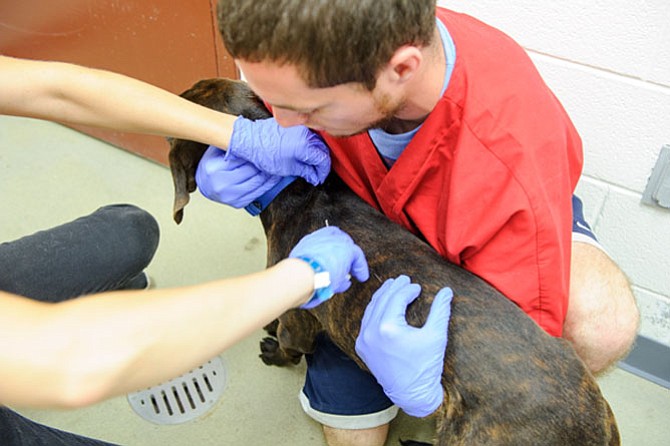A microchip is inserted just under the skin of a dog by Animal Welfare League of Alexandria workers. Photo by Shelley Castle Photography
A microchip is a small capsule of electronic circuitry about the size of a grain of rice that can be easily injected under a pet’s skin by a veterinary professional. Each microchip transmits a unique identification number that can be read with a microchip scanner and used to look up the pet owner’s contact information; countless lost pets have been reunited with their owners using this technology.
The Animal Welfare League of Alexandria (AWLA) recently offered microchip scanning at two community events, revealing critical issues pet owners should be aware of when using this technology. Of the 64 dogs scanned at these events, 43 were confirmed to be microchipped as their owners thought. Three of the dogs had microchips that were extremely difficult to find, one had a chip that could not be located and one had a chip with a number that could not be traced. Fourteen had chips that their owners were not aware of and therefore had not kept their contact information up to date in the microchip registry.
Here are some common issues with microchipping technology—and how best to handle them:
Issue: Animal has a microchip, but it is not found when the animal is scanned.
Solution: Microchips are inserted at the top of the neck in dogs and cats; however, as animals grow, the chip can sometime fall out or “migrate” to other areas on the body and be missed by the scanner, especially if the animal is scanned quickly. AWLA recommends that pet owners have their pets scanned at every regular checkup by a veterinarian to ensure the chip can be found easily.
Issue: The animal’s microchip number is found when the animal is scanned, but the microchip number does not correlate with a specific company to call about its registration.
Solution: Microchips are now being manufactured with numbering systems that do not necessarily match the company that manufactured them; registration is sometimes handled by a third-party company. To address this problem, a national registry has been established at www.petmicrochiplookup.org. This allows the microchip manufacturer and third-party registration companies to share information. A pet owner should be able to search the pet’s microchip number in the website and obtain contact information for the microchip company along with information about the pet. Not all microchip manufacturers or third-party registries participate in this, which may yield a “no information found” result on the website. If your pet’s microchip number shows up as “no information found,” you should also consider registering your pet’s microchip with a company like www.foundanimals.org that will then upload your registration to the national registry. This solution can be effective if the animal shelter/veterinary clinic that finds your animal knows to check petmicrochiplookup.org.
Issue: The animal’s microchip number is found and is easily associated with a company to call for the registration, but the contact information is out of date or no longer associated with the pet owner.
Solution: A microchip is only as good as the information associated with its number. It is very important to check that your pet’s microchip registration information is kept up to date. You may want to consider contacting your pet’s microchip company once a year to ensure that the primary and secondary contact information is correct and that you have listed an “emergency contact” as part of the registration.
To ensure that pet owners get the best possible protection from microchips, the AWLA recommends:
Have the pet scanned at each veterinary appointment to confirm the location of the chip, or bring your pet to the AWLA-operated facility at 4101 Eisenhower Ave. during open hours to have it scanned by AWLA staff. Then make a note of the chip number along with the name of the microchip company and store that information in a safe location.
Call your microchip company and confirm that your contact information is registered correctly. Update your information with the company any time your contact information changes. Add a secondary contact person and an emergency contact to the record, preferably someone who doesn’t change addresses often.
Enter your pet’s microchip number into www.petmicrochiplookup.org and make sure that the information links to a company that has your current contact information. If it does not, consider registering your pet’s chip number for free at www.foundanimals.org since they upload this information to the www.petmicrochiplookup.org.
The Animal Welfare League of Alexandria is an independent, local, 501(c)(3) non-profit organization that operates the animal shelter for the City of Alexandria. The AWLA is committed to ending animal homelessness, promoting animal welfare, and serving as an educational resource for the City of Alexandria community. More information is at AlexandriaAnimals.org.
